|
Postcard 03 (March 17, 2016)
Last night : northern lights over Nanuq's Cove
 clic to zoom - all here...
clic to zoom - all here...
Here comes the Sun
(March 3, 2016)
Above : first sun on board. (photo Peter Gallinelli)
Due to an exceptional meteorological situation, temperatures
are exceptionally mild for winter at 77°N: -20°C.
The sky is clear and the big fjord is now in bright sunlight.
In Nanuq's Cove we still have to wait. But today, 3rd of March,
Nanuq gets her first light from the sun.
After five months of arctic night we fully appreciate our
relation to the sun, representing 99.9% of the solar system's
mass and fueling close to 100% of all energy available on
planet earth, free of charge and at our scale indefinitely.
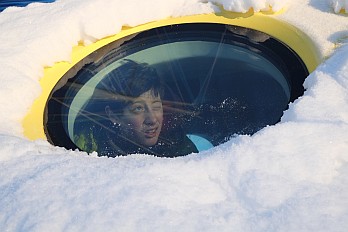
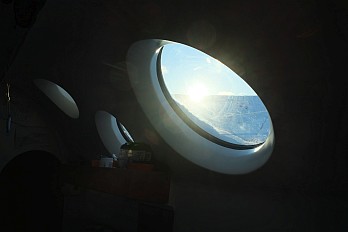
First sun 2016, from and inside our
vessel (photos Peter Gallinelli)
So time has come to clear the windows from the snow cover
used to reduce thermal losses during the arctic winter. The
sun is back and and time has come to inaugurate the solar
photovoltaic system.
The transition from night ot day is impressive. Twilight
is never ending. We have the impression that there is more
light than anywhere else in the world. Calculations prove
our impression: whilst potential sunshine hours are the same
at any location on earth (50%), in the Arctic one will observe
only 20% of dark night, half of what occurs close to the equator.
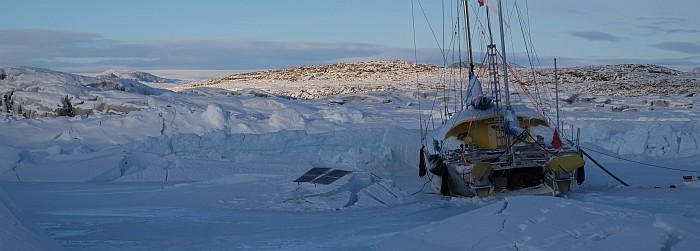
Nanuq and the new solar plan (photo
Peter Gallinelli)
As a living laboratory, the 'passive igloo' is in the middle
of long term resistance testing :
a) Still little or no wind. We now expect
the solar system to take over once sunshine is bright. Four
high efficiency panels sum up to 200 Watts. We have calculated
optimum orientation taking into account apparent sun movement,
obstructions and albedo of snow. A MPPT (maximum power point
tracker) regulator optimizes production as a function of cell
specifications.
b) Due to the movements of the ice shelf, the buried
pipe system has been perforated and has become useless.
This means that there is no more preheating of fresh air and
as a consequence the exhaust air heat recovery system cannot
perform to its optimum.
c) The composting toilets are a success,
even for our occasional visitors who discover this system
for the first time: they are amazed. Especially odors are
perfectly managed, much better than on a traditional WC. And
at the same time the composting unit will digest all organic
waste, in addition with paper and cardboard used to substitute
sawdust or turf. In six months we have accumulated no more
than six 20 liter bags of dry, clean incineratable waste the
can easily be stored on board until the first reasonable call.
d) Our vessel, an Integral 60, is perfectly
suited for this expedition. Life on board is most comfortable.
The big rear deck and garage are useful for the life on the
ice shelf. The sturdy hull doesn't mind scratches or chocs.
The sanitary systems are simple and efficient: they are inspired
from the Greenlandic state of the art. We draw water from
a big plastic barrel holding fresh water from the lake or
from molten ice standing in the cabin. Used water is collected
in a bucket below the sink and emptied as required. We use
about 30 litrers per person per week. The air-cooled engine
doesn't require any specific attention and runs even when
packed in ice or on dry dock. Last but not least, the reinforced
thermal insulation is without any doubt a fundamental feature
for this kind of navigation.
e) We were doubting if our stock of food
would be sufficient. Since January, our diet has been improved
with fresh fish and game, adding essential calories and nutrients.
By miracle we could save cabbage from September and have a
fresh salad once in a time. We don't miss anything and fantasies
of unavailable food have not occurred.
f) Being cut off from the 'world', tools and materials
for repairs and DIY are most essential. This applies also
to knowledge and: encyclopedia, dictionary, calculation tables,
atlases ... specially in paper format are important. Self
sufficiency also means that one has the keys to questions,
developing ideas and projects.
g) The day-night rhythm has settled to normal
... for some time at least. This has allowed our sleeping
patterns to return to 'normal'. After the months of twilight
and darkness will follow the arctic day where the sun never
sets ... stories to come.
Twilight
(March 3, 2016)

Twilight banner for March 3rd : twilight
application
Although head lamps have undergone huge progress, when living
in the wild one will account for daylight to organise outdoor
activities. It is not a big surprise that wildlife has completely
adapted to daylight patterns. Not only sunshine hours, but
specially twilight have big importance and this is even more
so in the high latitudes where the sun often 'hides' just
some degrees under the horizon. Twilight is exceptionnally
long and specially apreciated during the winter months.
The Arctic regions have access to more daylight than any
other part of the world, with a maximum at roughly 75°
latitude. But solar energy becomes less as one moves to the
north, which explains the low temperatures.
Tables and graphs giving information on twilight are easy
to find, but sometimes it is just fun to understand things
by making your own calculations. At last, twilight and solar
energy calculations have been translated into a colorful free
software tool. This is a way to celebrate sunlight and a contribution
to a better understanding of our environment. Download, follow
this link...
The colours have been chosen so as to give a qualitative
perception that can be useful for hiking or navigation (left
hand capture). Whilst preparing the setup of our solar panels
the same calculations have been extended to evaluate solar
energy taking into account latitude, obstructions and the
snow's albedo (right hand capture).
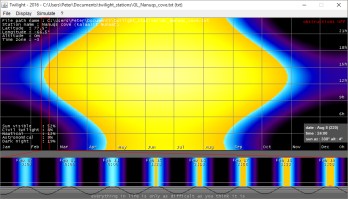
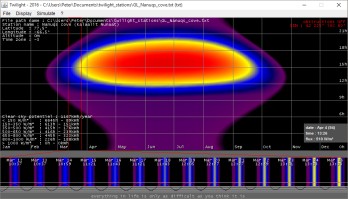
Screen shots 'Twilight application'
: twilight at Nanuq's Cove and simulation for the solar collectors
In order to share daylight impressions, a twilight banner
will accompany each news from now on (see above).
Yellow : sun potentially visible (except for obstructions
and weather)
Light blue : civil twilight
Dark blue : nautical twilight
Violet : astronomical twilight
Black : black night (not taking into account moonligh, starlight,
northern lights, halo from artificial lighting)
More information and download, follow this link...
News
from the ice shelf (February 22nd, 2016)

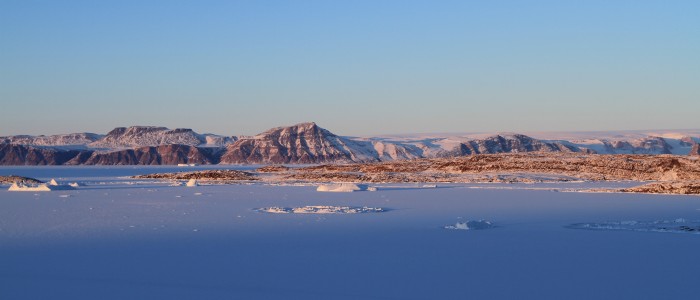
First day of sun in Qeqertat : February
19th, 2016 (photo Matthias Waurick)
Once again, news will be brought to you by visitors heading
back home to Europe. Have fun!
Peter & crew
Seqineq : the sun
rises (February 18, 2016)
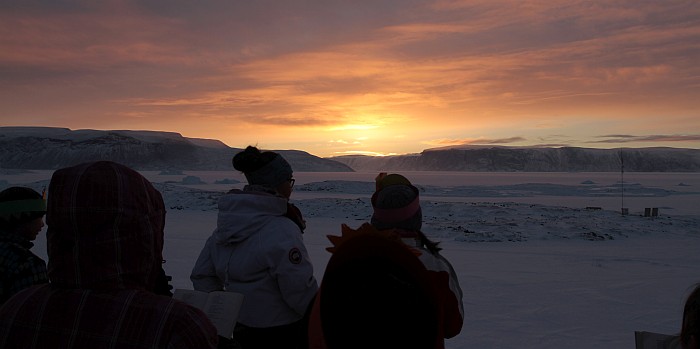 Welcome
to the sun : villagers celebrating the first sun in Qeqertat,
February 18th, 2016, 77.5° N (photo Matthias Waurick) Welcome
to the sun : villagers celebrating the first sun in Qeqertat,
February 18th, 2016, 77.5° N (photo Matthias Waurick)
This is an important day: at a distance of 700 nautical miles
distance from the pole and after months of dark, the sun appears.
The inhabitants walk to a hill close to the village to welcome
the sun with songs and celebrations. A great moment of joy!
This is the end of the arctic night. Daylight grows in length
at a spectacular pace. Each day gives more than an hour of
additional sunshine. In Nanuq's Cove we still have to be patient
for a week or two. The last sunshine was in October .. a long
time ago!
But, the arctic night is not complete dark. We experienced
magnificent lights, including blue moon, aurora borealis,
starlight as can be seen only far away from civilization.
So we welcome the sun more as a symbol of change than a liberation.
A new chapter of a voyage in time.
The village is busy: the halibut season is at its maximum
and the population has almost doubled. Numerous fishing cabins
have been set up on the ice shelf at 4 to 5km distance. Everybody
is busy and we are invited to participate.
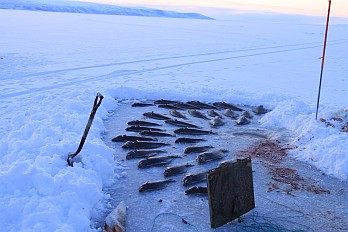
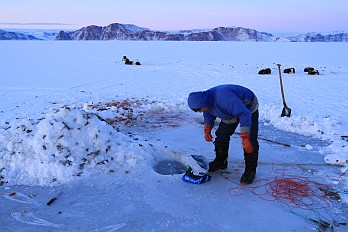
Traditional halibut fishing, Qeqertat,
February 2016 (photos Matthias Waurick)
Meanwhile, the 'passive igloo' performs to entire satisfaction
even though we experience temperatures that are well below
what we had expected. Besides a minor sensor failure, all
system perform well since the beginning. Wind is still lacking,
but soon we will be able to take advantage of solar radiation
reducing need for artificial lighting, giving warmth through
the windows and solar power.
The challenges are:
- the ice building up around the boat
- the maintenance of all systems
- use of cameras in extreme cold environment
- energy management
The highlights are:
- life on board
- self sufficiency
- growing daylight
And as far as the crew is concerned, everything is fine.
No nostalgia for unavailable food, items or warmth. We live
in perfect harmony with our environment and the 'home' we
have designed and built. No chores, but simply tasks. Like
day, night and twilight, everything is progressive and takes
time. Things happen at a natural pace and not in a race against
time. It takes the time it needs. No more. No less. This is
a real privilege that we share with the villagers.
Shisha
(February 12, 2016)

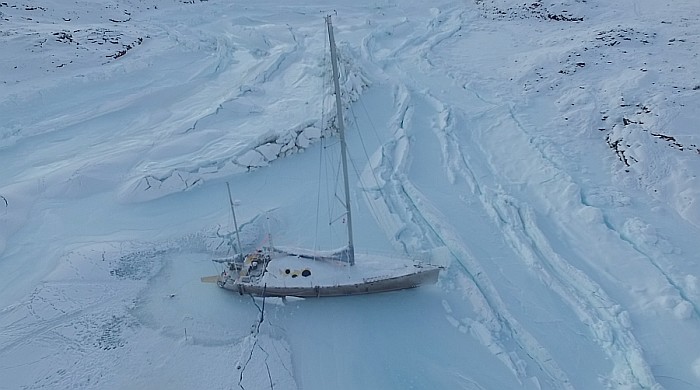 Nanuq
at the edge of 'Shisha', the moving ice. We ow this wonderful
view from above to Matthias who brought his drone and made
it fly at below -35°C temperatures, using heat bags and
freezing his fingers! (photo Mathias Waurick) Nanuq
at the edge of 'Shisha', the moving ice. We ow this wonderful
view from above to Matthias who brought his drone and made
it fly at below -35°C temperatures, using heat bags and
freezing his fingers! (photo Mathias Waurick)
We are in the very middle of winter. Since the beginning
of February temperatures are below -30°C. The ice shelf
is more than 1m thick. Due to tides the ice crust twists and
bends and compression ridges appear all around our mooring,
some are of them are several meters in height. The ice cracks
in an impressive way. We hope that the situation will not
get worse. All we can do is wait and see.
The Greenlanders call this the 'sissa' - pronounce 'shisha'.
It is the transition zone between the shore and the solid
ice shelf. It extends to approximately 10 times the spring
tide range. In our place this means 20 to 30 meters ... and
we are pretty close!
When going from the shelf to land, or the other way, this
is the critical and sometime dangerous passage. The ice is
slippery and one can fall or take à bath. Pieces of
ice may crumble or tip over...
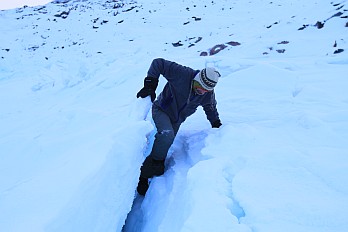
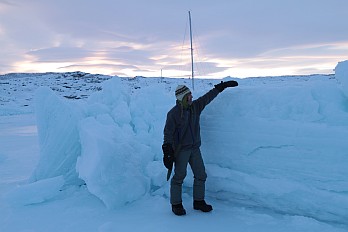 Peter
in and in f ront of the sissa (photos Matthias Waurick) Peter
in and in f ront of the sissa (photos Matthias Waurick)
A winter mooring must be planned taking into account this
feature, giving sufficient room and depth of water: three
times the expected ice thickness should be a reasonable depth.
The quality of ice depends on its origin. Fresh water such
as found in lakes or the northern Baltic waters tend to be
very compact and perfectly clear. The locals venture upon
as little as 5cm thickness, reserved to the expert!, and 10cm
seem OK to stroll upon safely.
Sea ice is very different. More translucent than transparent,
it contains many irregularities and is much more fragile.
10cm thickness are a minimum - we used dry-suits - and 20cm
are a reasonable minimum for a safe walk. We removed the mooring
lines when the shelf reached 20cm.
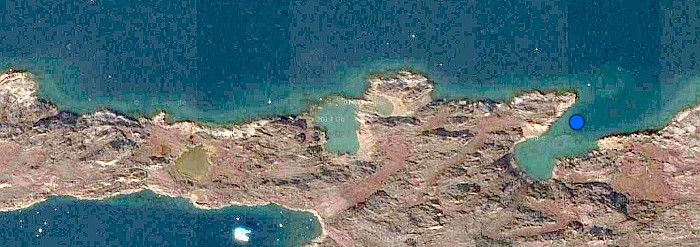
Nanuq's Cove : the winter mooring site:
77°29.5'N 66°33.5'W : Greenland (extract wikimapia.org)
Strong autum gales give a limit to the anchor option since
winds may exceed 65 knots. Best for safety are land lines.
But they require an appropriate bay and long lines to keep
safe of the 'sissa'. For this region we would recommend four
80m lines holding each 50% of the vessels displacement. Load
straps are very useful to attach to rocks on the shore.
Postcard 02 (February 9, 2016)
-35°C
 clic to zoom - all here...
clic to zoom - all here...
Good news (February
1, 2016)
This is not an interruption of program. But we may remind
that 'the passive igloo project' would not have been possible
without the help of numerous partners, passionate folks, friends,
family and the will to make this project come true.
We would like to announce the partership with SIG,
services industriels de Genève.
Gilles Garazi, Directeur Transition Energétique, SIG:
"SIG est une entreprise publique genevoise active notamment
dans le domaine des énergies, de la gestion de l’eau
et de la valorisation des déchets. Engagée résolument
dans la transition énergétique, SIG pense que
les énergies peuvent être consommées mieux…
et moins. Passive Igloo est une initiative pertinente, innovante,
et qui va dans le sens d’un avenir fondé sur
les énergies propres et le développement durable.
C'est pourquoi nous soutenons ce projet."
Peter Gallinelli, Initiateur du 'passive igloo project':
"C’est une formidable nouvelle! Grâce au
soutien de SIG, des systèmes énergétiques
du 'passive igloo' pourront être complétés.
Nous avions approché SIG car il nous paraissait pertinent
que le fournisseur d'énergies de Genève s'intéresse
à un projet qui explore les énergies de demain.
Ce partenariat est pour nous une belle reconnaissance du projet."

Voyage to Qaanaaq
(January 26, 2016)

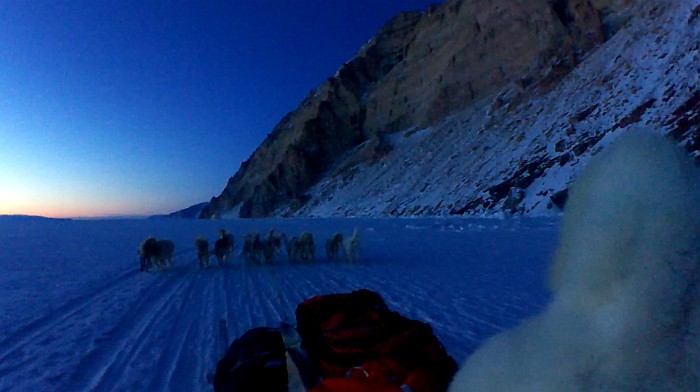
En route for Qaanaaq - twilight in January
(photo Peter Gallinelli)
The polar bear to the right hand is Thomas, our friend and
guide for this voyage to the capital at a days ride from our
winter camp.
During the 48 hours stay in Qaanaaq, I have access to Internet.
Incredible: a huge antenna dish connects this remote place
to the South and the world of binary fluxes. We are too close
to the pole to have satellite Internet.
While Qeqertat peacefully lives at the edge of civilization,
Qaanaaq and its 500 inhabitants expresses the duality of a
society in transition from an ancient and traditional world
into the 21 century of competing economy and technology. Western
food and products contrast with ancient traditions. Discussions
are very instructive and reveal a somehow bitter feeling toward
Danish and American intervention. But on the other hand, nobody
criticizes radio or TV that diffuse non-stop Western culture
programs.
From Savissivik to Siorapaluq, the people of the North have
their own culture, their own language. A handful of 600 individuals
living on a territory as large as a state. Will they succed
to conserve their identity? The world is on the move and from
a traditional culture of hunting, the wind blows towards fishing,
a lucrative business. But for how long?
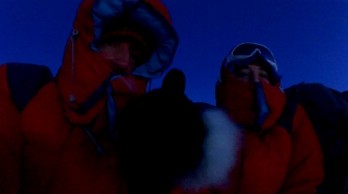
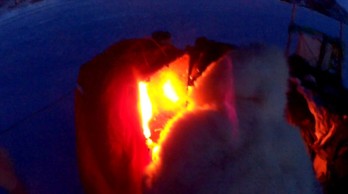
En voyage: left Peter et Mathilde dressed
in warm down clothes, right hand Thomas dressed in traditional
fur clothes, preparing the 'Primus Box' (photos Peter Gallinelli)
Post card 01 (January 24, 2016)
January 2016 - blue moon over 'Nanuq's Cove' - 77°29.5'N
66°33.5'W
 clic to zoom - all here...
clic to zoom - all here...
Word list greenlandic
- english - french (January 22, 2016)
Happy New Year 2016
(January 15, 2016)
Outside : cold : -40°C

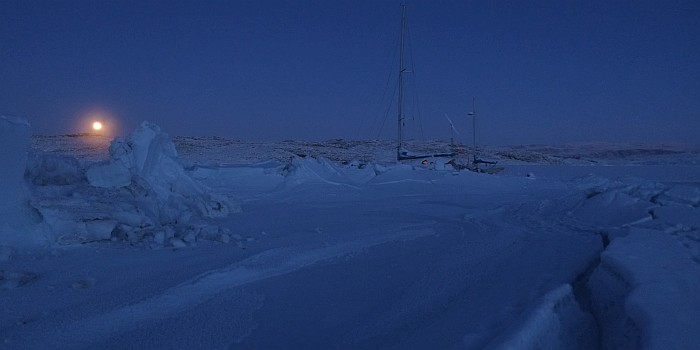
January 2016 - Blue Moon : grounded
on another planet - Nanuq in the Arctic (photo Peter Gallinelli)
Inside : warm : +20°C
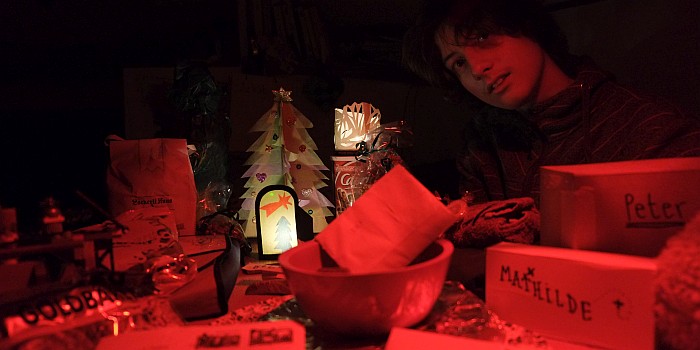
Life on board contrasts with our environment
- Christmas 2015 on board Nanuq (photos Peter Gallinelli)
Blue for cold, red for
warm: 60°C separate outside from inside. We use simple
solutions to make human life possible in one of the most magical
but also lethal environments. The rules are very clear and
allow for no improvisation. The abundance of wildlife stands
in contrast with the harsh conditions. This is a lesson of
life.
This voyage is not reasonable, it is a quest.
As such it opens new perspectives regarding our knowledge
of the world, others and ourselves and the relationships between
these.
The access, from our sofa, to an almost limitless amount
of information might give the impression that we can know
everything. However, only the confrontation with the real
world allows an authentic experience, an experience where
our skills and our integrity play a major
role. The act of doing is what makes the
difference between knowledge and experience.
Adventure is about experience. It is choosing the road least
travelled, a road of unease, to unleash from the ballast of
habits and certainties and allow to uprise: the horizon moves
back as one rises: one can see further, wider, and maybe clearer.
This is what we wish you for 2016: an extraordinary and adventurous
year.
The ongoing challenges are:
- the effect of tides (2-3m) on the surrounding ice shelf,
making it twist and brake up
- sleeping patterns - our natural rhythm shifts later 45min
each day... me becomme better with daylilght
- the organisation of the coming summer with restricted
access to communication
Bai- takussagut (see word list)
Peter & crew
|